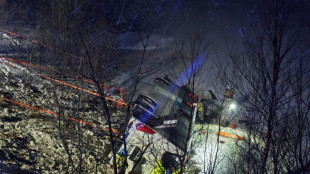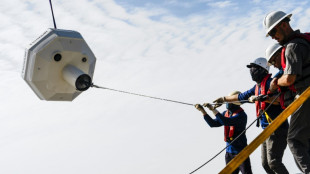-
 Guardiola won't quit troubled Man City
Guardiola won't quit troubled Man City
-
Gaza child amputees get new limbs but can't shake war trauma

-
 Evergreen Brignone powers to Semmering giant slalom win
Evergreen Brignone powers to Semmering giant slalom win
-
Thousands in Georgia human chain as pro-EU protests enter 2nd month

-
 Turkey's pro-Kurd party meets jailed PKK leader
Turkey's pro-Kurd party meets jailed PKK leader
-
WHO chief says narrowly escaped death in Israeli strikes on Yemen airport

-
 Swiss Monney takes maiden World Cup win in Bormio downhill
Swiss Monney takes maiden World Cup win in Bormio downhill
-
De Minaur wins but Australia crash to Argentina at United Cup

-
 EU universal charger rules come into force
EU universal charger rules come into force
-
Evenepoel targets return in time for Ardennes classics

-
 Duffy bowls New Zealand to T20 victory over Sri Lanka
Duffy bowls New Zealand to T20 victory over Sri Lanka
-
Turkey's pro-Kurd party to meet jailed PKK leader on Saturday

-
 Gaza hospital shut after Israeli raid, director held: health officials
Gaza hospital shut after Israeli raid, director held: health officials
-
Surgery for French skier Sarrazin 'went well': federation

-
 Mitchell, Bracewell boost New Zealand in Sri Lanka T20
Mitchell, Bracewell boost New Zealand in Sri Lanka T20
-
Kyrgios says tennis integrity 'awful' after doping scandals

-
 S. Korean prosecutors say Yoon authorised 'shooting' during martial law bid
S. Korean prosecutors say Yoon authorised 'shooting' during martial law bid
-
Vendee Globe skipper Pip Hare limps into Melbourne after dismasting

-
 Reddy's defiant maiden ton claws India back into 4th Australia Test
Reddy's defiant maiden ton claws India back into 4th Australia Test
-
Doubles partner Thompson calls Purcell doping case 'a joke'

-
 Reddy reaches fighting maiden century for India against Australia
Reddy reaches fighting maiden century for India against Australia
-
Sabalenka enjoying 'chilled' rivalry with Swiatek

-
 Political turmoil shakes South Korea's economy
Political turmoil shakes South Korea's economy
-
New mum Bencic wins first tour-level match since 2023 US Open

-
 'Romeo and Juliet' star Olivia Hussey dies aged 73
'Romeo and Juliet' star Olivia Hussey dies aged 73
-
Brown dominates as NBA champion Celtics snap skid

-
 Indian state funeral for former PM Manmohan Singh
Indian state funeral for former PM Manmohan Singh
-
France asks Indonesia to transfer national on death row

-
 Ambitious Ruud targets return to top five in 2025
Ambitious Ruud targets return to top five in 2025
-
Late bloomer Paolini looking to build on 'amazing' 2024

-
 Australia remove Pant, Jadeja as India reach 244-7 at lunch
Australia remove Pant, Jadeja as India reach 244-7 at lunch
-
Scheffler sidelined by Christmas cooking injury

-
 Rice seeks trophies as Arsenal chase down 'full throttle' Liverpool
Rice seeks trophies as Arsenal chase down 'full throttle' Liverpool
-
Trump asks US Supreme Court to pause law threatening TikTok ban

-
 Arsenal edge past Ipswich to go second in Premier League
Arsenal edge past Ipswich to go second in Premier League
-
LawConnect wins punishing and deadly Sydney-Hobart yacht race

-
 Ronaldo slams 'unfair' Ballon d'Or result after Vinicius snub
Ronaldo slams 'unfair' Ballon d'Or result after Vinicius snub
-
Several wounded N.Korean soldiers died after being captured by Ukraine: Zelensky

-
 Fresh strike hits Yemen's rebel-held capital
Fresh strike hits Yemen's rebel-held capital
-
Netflix with Beyonce make splash despite NFL ratings fall

-
 Bird flu mutated inside US patient, raising concern
Bird flu mutated inside US patient, raising concern
-
Slovakia says ready to host Russia-Ukraine peace talks

-
 Maresca challenges Chelsea to react to Fulham blow
Maresca challenges Chelsea to react to Fulham blow
-
Tech slump slays Santa rally, weak yen lifts Japan stocks higher

-
 Test records for Zimbabwe and Williams as Afghanistan toil
Test records for Zimbabwe and Williams as Afghanistan toil
-
LawConnect wins punishing Sydney-Hobart yacht race

-
 Barca's Yamal vows to 'come back better' after ankle injury
Barca's Yamal vows to 'come back better' after ankle injury
-
Olmo closer to Barcelona exit after registration request rejected

-
 Watching the sun rise over a new Damascus
Watching the sun rise over a new Damascus
-
Malaysia man flogged in mosque for crime of gender mixing

| RBGPF | 100% | 59.84 | $ | |
| SCS | 0.58% | 11.97 | $ | |
| CMSD | -0.67% | 23.32 | $ | |
| RIO | -0.41% | 59.01 | $ | |
| RELX | -0.61% | 45.58 | $ | |
| GSK | -0.12% | 34.08 | $ | |
| NGG | 0.66% | 59.31 | $ | |
| RYCEF | 0.14% | 7.27 | $ | |
| BCC | -1.91% | 120.63 | $ | |
| CMSC | -0.85% | 23.46 | $ | |
| BTI | -0.33% | 36.31 | $ | |
| VOD | 0.12% | 8.43 | $ | |
| BP | 0.38% | 28.96 | $ | |
| AZN | -0.39% | 66.26 | $ | |
| JRI | -0.41% | 12.15 | $ | |
| BCE | -0.93% | 22.66 | $ |
Hurricane Otis cuts off Mexico's battered Acapulco
Mexican authorities rushed to send emergency aid and assess damage in the Pacific beach resort of Acapulco on Wednesday after a powerful hurricane severed communications and road links.
President Andres Manuel Lopez Obrador said that there were no initial reports of deaths after Otis came ashore during the night as a "potentially catastrophic" Category 5 hurricane.
"There's material damage and blocked roads. The highway to Acapulco has landslides," he said at his morning news conference.
Officials emphasized that the lack of communications made it difficult to know the extent of the damage.
The government was working to restore communication in the affected area, Lopez Obrador said.
A convoy carrying humanitarian aid set off to try to reach Acapulco by land due to the impossibility of flying into the city, authorities said.
"The urgent thing is to attend to the affected population. We still don't have the damage assessment because there's no communication," Civil Protection national coordinator Laura Velazquez said.
Even the navy and military were "seriously affected," she added.
Otis was downgraded to a Category 1 storm with maximum sustained winds of around 80 miles (130 kilometers) per hour, down from 165 miles per hour when it hit the coast, the US National Hurricane Center (NHC) said.
The storm had rapidly strengthened to the most powerful category of the five-step Saffir-Simpson scale as it neared land, taking authorities by surprise.
"Rarely, according to records, does a hurricane develop so quickly and with such force," Lopez Obrador said.
On Tuesday night, the Mexican president had appealed on social media for people to move to emergency shelters and away from rivers, streams and ravines.
- Tourists take shelter -
At dawn, much of Acapulco, a city of about 780,000 inhabitants in Guerrero state, was still without power.
State electricity company CFE later said that it had managed to restore supply to 40 percent of the more than half a million affected customers, most of them located in Acapulco.
Videos posted on social media showed damaged buildings, shattered windows and tourists using beds and mattresses as protective barriers in their hotel rooms.
Others took refuge in bathrooms.
Before the storm hit, many people bought last-minute supplies of food and water, with some business and homeowners boarding up their windows.
More than 500 emergency shelters were opened for residents.
Heavy rains deluged Guerrero and parts of neighboring Oaxaca -- two of Mexico's poorest states, home to remote mountain communities.
"This rainfall will produce flash and urban flooding, along with mudslides in areas of higher terrain," the NHC warned.
Hurricanes hit Mexico every year on both its Pacific and Atlantic coasts, usually between May and November, though few make landfall as a Category 5.
In October 1997, Hurricane Pauline hit Mexico's Pacific coast as a Category 4 storm, leaving more than 200 people dead, some of them in Acapulco.
It was one of the deadliest hurricanes to batter Mexico.
In October 2015, Patricia became the most powerful hurricane ever recorded, pummeling Mexico's Pacific coast with sustained winds of 200 miles per hour.
But the storm caused only material damage and no deaths as it made landfall in a sparsely populated mountainous area.
Just this week, Tropical Storm Norma left three people dead, including a child, after making landfall for a second time in the northwestern state of Sinaloa.
Earlier this month, two people died when Hurricane Lidia, an "extremely dangerous" Category 4 storm, struck the western states of Jalisco and Nayarit.
Scientists have warned that storms are becoming more powerful as the world gets warmer with climate change.
A.P.Maia--PC




